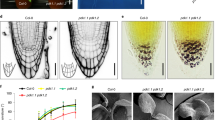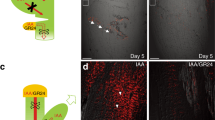Abstract
Phototropism is an adaptation response, through which plants grow towards the light1. It involves light perception and asymmetric distribution of the plant hormone auxin2,3,4,5,6,7,8,9,10,11,12. Here we identify a crucial part of the mechanism for phototropism, revealing how light perception initiates auxin redistribution that leads to directional growth. We show that light polarizes the cellular localization of the auxin efflux carrier PIN3 in hypocotyl endodermis cells, resulting in changes in auxin distribution and differential growth. In the dark, high expression and activity of the PINOID (PID) kinase correlates with apolar targeting of PIN3 to all cell sides. Following illumination, light represses PINOID transcription and PIN3 is polarized specifically to the inner cell sides by GNOM ARF GTPase GEF (guanine nucleotide exchange factor)-dependent trafficking. Thus, differential trafficking at the shaded and illuminated hypocotyl side aligns PIN3 polarity with the light direction, and presumably redirects auxin flow towards the shaded side, where auxin promotes growth, causing hypocotyls to bend towards the light. Our results imply that PID phosphorylation-dependent recruitment of PIN proteins into distinct trafficking pathways is a mechanism to polarize auxin fluxes in response to different environmental and endogenous cues.
This is a preview of subscription content, access via your institution
Access options
Subscribe to this journal
Receive 12 print issues and online access
$209.00 per year
only $17.42 per issue
Buy this article
- Purchase on Springer Link
- Instant access to full article PDF
Prices may be subject to local taxes which are calculated during checkout





Similar content being viewed by others
References
Whippo, C. W. & Hangarter, R. P. Phototropism: bending towards enlightenment. Plant Cell 18, 1110–1119 (2006).
Sakai, T. et al. Arabidopsis nph1 and npl1: blue light receptors that mediate both phototropism and chloroplast relocation. Proc. Natl Acad. Sci. USA 98, 6969–6974 (2001).
Briggs, W. R. et al. The phototropin family of photoreceptors. Plant Cell 13, 993–997 (2001).
Inada, S., Ohgishi, M., Mayama, T., Okada, K. & Sakai, T. RPT2 is a signal transducer involved in phototropic response and stomatal opening by association with phototropin 1 in Arabidopsis thaliana. Plant Cell 16, 887–896 (2004).
Lariguet, P. et al. PHYTOCHROME KINASE SUBSTRATE 1 is a phototropin 1 binding protein required for phototropism. Proc. Natl Acad. Sci. USA 103, 10134–10139 (2006).
Motchoulski, A. & Liscum, E. Arabidopsis NPH3: a NPH1 photoreceptor-interacting protein essential for phototropism. Science 286, 961–964 (1999).
Haga, K., Takano, M., Neumann, R. & Iino, M. The rice COLEOPTILE PHOTOTROPISM1 gene encoding an ortholog of Arabidopsis NPH3 is required for phototropism of coleoptiles and lateral translocation of auxin. Plant Cell 17, 103–115 (2005).
Went, F. W. Reflections and speculations. Annu. Rev. Plant Physiol. 25, 1–26 (1974).
Li, Y., Hagen, G. & Guilfoyle, T. J. An auxin-responsive promoter is differentially induced by auxin gradients during tropisms. Plant Cell 3, 1167–1175 (1991).
Esmon, C. A. et al. A gradient of auxin and auxin-dependent transcription precedes tropic growth responses. Proc. Natl Acad. Sci. USA 103, 236–241 (2006).
Fuchs, I., Philippar, K., Ljung, K., Sandberg, G. & Hedrich, R. Blue light regulates an auxin-induced K+-channel gene in the maize coleoptile. Proc. Natl Acad. Sci. USA 100, 11795–11800 (2003).
Briggs, W. R. Mediation of phototropic responses of corn coleoptiles by lateral transport of auxin. Plant Physiol. 38, 237–247 (1963).
Epel, B. L., Warmbrodt, R. P. & Bandurski, R. S. Studies on the longitudinal and lateral transport of IAA in the shoots of etiolated corn seedlings. J. Plant Physiol. 140, 310–318 (1992).
Bethany, B. S-E. & EL Liscum, E. Disruptions in AUX1-dependent auxin influx alter hypocotyl phototropism in Arabidopsis. Mol. Plant 1, 129–144 (2008).
Swarup, R. et al. Root gravitropism requires lateral root cap and epidermal cells for transport and response to a mobile auxin signal. Nat. Cell Biol. 7, 1057–1065 (2005).
Geisler, M. & Murphy, A. S. The ABC of auxin transport: the role of p-glycoproteins in plant development. FEBS Lett. 580, 1094–1102 (2006).
Petrášek, J. et al. PIN proteins perform a rate-limiting function in cellular auxin efflux. Science 312, 914–918 (2006).
Winiewska, J. et al. Polar PIN localization directs auxin flow in plants. Science 312, 883 (2006).
Blakeslee, J. J. et al. Relocalization of the PIN1 auxin efflux facilitator plays a role in phototropic responses. Plant Physiol. 134, 28–31 (2004).
Friml, J., Winiewska, J., Benková, E., Mendgen, K. & Palme, K. Lateral relocation of auxin efflux regulator PIN3 mediates tropism in Arabidopsis. Nature 415, 806–809 (2002).
Benková, E. et al. Local, efflux-dependent auxin gradients as a common module for plant organ formation. Cell 115, 591–602 (2003).
Friml, J. et al. Efflux-dependent auxin gradients establish the apical-basal axis of Arabidopsis. Nature 426, 147–153 (2003).
Blakeslee, J. J. et al. Interactions among PIN-FORMED and P-glycoprotein auxin transporters in Arabidopsis. Plant Cell 19, 131–147 (2007).
Mravec, J. et al. Interaction of PIN and PGP transport mechanisms in auxin distribution-dependent development. Development 135, 3345–3354 (2008).
Nagashima, A. et al. Phytochromes and cryptochromes regulate the differential growth of Arabidopsis hypocotyls in both a PGP19-dependent and a PGP19-independent manner. Plant J. 53, 516–529 (2008).
Gendreau, E. et al. Cellular basis of hypocotyl growth in Arabidopsis thaliana. Plant Physiol. 114, 295–305 (1997).
Gray, W. M., Ostin, A., Sandberg, G., Romano, C. P. & Estelle, M. High temperature promotes auxin-mediated hypocotyl elongation in Arabidopsis. Proc. Natl Acad. Sci. USA 95, 7197–7202 (1998).
Abas, L. et al. Intracellular trafficking and proteolysis of the Arabidopsis auxin-efflux facilitator PIN2 are involved in root gravitropism. Nat. Cell Biol. 8, 249–256 (2006).
Kleine-Vehn, J. et al. ARF GEF-dependent transcytosis and polar delivery of PIN auxin carriers in Arabidopsis. Curr. Biol. 18, 526–531 (2008).
Dhonukshe, P. et al. Clathrin-mediated constitutive endocytosis of PIN auxin efflux carriers in Arabidopsis. Curr. Biol. 17, 520–527 (2007).
Geldner, N., Friml, J., Stierhof, Y. D., Jürgens, G. & Palme, K. Auxin transport inhibitors block PIN1 cycling and vesicle trafficking. Nature 413, 425–428 (2001).
Shevell, D. E. et al. EMB30 is essential for normal cell division, cell expansion, and cell adhesion in Arabidopsis and encodes a protein that has similarity to Sec7. Cell 77, 1051–1062 (1994).
Geldner, N. et al. The Arabidopsis GNOM ARF-GEF mediates endosomal recycling, auxin transport, and auxin-dependent plant growth. Cell 112, 219–230 (2003).
Geldner, N. et al. Partial loss-of-function alleles reveal a role for GNOM in auxin transport-related, post-embryonic development of Arabidopsis. Development 131, 389–400 (2004).
Kaiserli, E., Sullivan, S., Jones, M. A., Feeney, K. A. & Christie, J. M. Domain swapping to assess the mechanistic basis of Arabidopsis phototropin 1 receptor kinase activation and endocytosis by blue light. Plant Cell 21, 3226–3244 (2009).
Wan, Y. L. et al. The subcellular localization and blue light-induced movement of phototropin 1-GFP in etiolated seedlings of Arabidopsis thaliana. Mol. Plant 103, 103–117 (2008).
Christensen, S. K., Dagenais, N., Chory, J. & Weigel, D. Regulation of auxin response by the protein kinase PINOID. Cell 100, 469–478 (2000).
Benjamins, R., Quint, A., Weijers, D., Hooykaas, P. & Offringa, R. The PINOID protein kinase regulates organ development in Arabidopsis by enhancing polar auxin transport. Development 128, 4057–4067 (2001).
Friml, J. et al. A PINOID-dependent binary switch in apical-basal PIN polar targeting directs auxin efflux. Science 306, 862–865 (2004).
Michniewicz, M. et al. Antagonistic regulation of PIN phosphorylation by PP2A and PINOID directs auxin flux. Cell 130, 1044–1056 (2007).
Huang, F. et al. Phosphorylation of conserved PIN motifs directs Arabidopsis PIN1 polarity and auxin transport. Plant Cell 22, 1129–1142 (2010).
Inoue, S. et al. Blue light-induced autophosphorylation of phototropin is a primary step for signalling. Proc. Natl Acad. Sci. USA 105, 5626–5631 (2008).
Dhonukshe, P. et al. Plasma membrane bound AGC3 kinases phosphorylate PIN auxin carriers at TPRXS(N/S) motifs to direct apical PIN recycling. Development 137, 3245–3255 (2010).
Sorefan, K. et al. A regulated auxin minimum is required for seed dispersal in Arabidopsis. Nature 459, 583–586 (2009).
Kleine-Vehn, J. et al. PIN auxin efflux carrier polarity is regulated by PINOID kinase-mediated recruitment into GNOM-independent trafficking in Arabidopsis. Plant Cell 21, 3839–3849 (2009).
Kleine-Vehn, J., Ding, Z., Jones, A. R., Tasaka, M., Morita, M. T. & Friml, J. Gravity-induced PIN transcytosis for polarization of auxin fluxes in gravity-sensing root cells. Proc. Natl Acad. Sci. USA 107, 22344–22349 (2010).
Zádníková, P. et al. Role of PIN-mediated auxin efflux in apical hook development of Arabidopsis thaliana. Development 137, 607–617 (2010).
Hellemans, J., Mortier, G., De Paepe, A., Speleman, F. & Vandesompele, J. qBase relative quantification framework and software for management and automated analysis of real-time quantitative PCR data. Genome Biol. 8, R19.1–R19.14 (2007).
Christie, J. M., Swartz, T. E., Bogomolni, R. A. & Briggs, W. R. Phototropin LOV domains exhibit distinct roles in regulating photoreceptor function. Plant J. 32, 205–219 (2002).
Acknowledgements
We thank W. Briggs, G. Jürgens and I. Moore for sharing published materials; the Nottingham Arabidopsis Stock Centre (NASC) for seed stocks; D. Van Der Straeten, F. Vandenbussche and Q. Zhu for help with the blue-light treatment; W. Briggs, J. Christie and A. Murphy for helpful discussions; and M. De Cock for help in preparing the manuscript. This work was supported by grants from the Research Foundation-Flanders (Odysseus), from the Research Council for Earth and Life Sciences (C.S.G-A., ALW 813.06.004) with financial aid from the Dutch Organization of Scientific Research (NWO) to R.O., and from the Chinese Science Council (Y.F.). Work in the Fankhauser laboratory is supported by the Swiss National Science Foundation (grant no. 31003A_124747/1).
Author information
Authors and Affiliations
Contributions
Z.D., C.S.G-A., E.D., M.T., R.O., C.F. and J.F. conceived the study and designed the experiments. Z.D., E.D., C.S.G-A., J.K-V., Ł.Ł., Y.F. and M.T.M. carried out the experiments and analysed the data. Z.D. and J.F. wrote the manuscript.
Corresponding author
Ethics declarations
Competing interests
The authors declare no competing financial interests.
Supplementary information
Supplementary Information
Supplementary Information (PDF 399 kb)
Rights and permissions
About this article
Cite this article
Ding, Z., Galván-Ampudia, C., Demarsy, E. et al. Light-mediated polarization of the PIN3 auxin transporter for the phototropic response in Arabidopsis. Nat Cell Biol 13, 447–452 (2011). https://doi.org/10.1038/ncb2208
Received:
Accepted:
Published:
Issue Date:
DOI: https://doi.org/10.1038/ncb2208
This article is cited by
-
Parallel auxin transport via PINs and plasmodesmata during the Arabidopsis leaf hyponasty response
Plant Cell Reports (2024)
-
PHOTOTROPIN1 lysine 526 functions to enhance phototropism in Arabidopsis
Planta (2024)
-
Novel insights into maize (Zea mays) development and organogenesis for agricultural optimization
Planta (2023)
-
Hydrogen peroxide mediates high-intensity blue light-induced hypocotyl phototropism of cotton seedlings
Stress Biology (2023)
-
Plasmodesmata callose binding protein 2 contributes to the regulation of cambium/phloem formation and auxin response during the tissue reunion process in incised Arabidopsis stem
Journal of Plant Research (2023)



